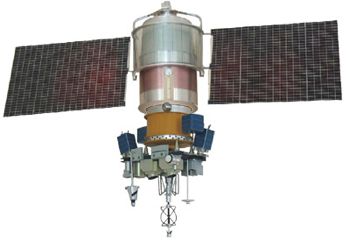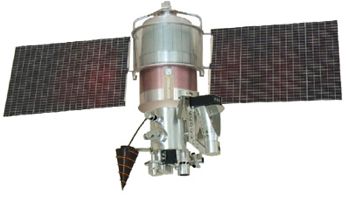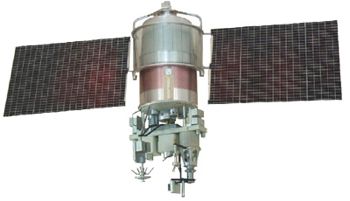
Home - Search - Browse - Alphabetic Index: 0- 1- 2- 3- 4- 5- 6- 7- 8- 9
A- B- C- D- E- F- G- H- I- J- K- L- M- N- O- P- Q- R- S- T- U- V- W- X- Y- Z
Resurs-O1
 Resurs-O1 No. 4 Credit: Manufacturer Image |
AKA: 11F697;Meteor-Priroda. Status: Operational 1985. First Launch: 1985-10-03. Last Launch: 1998-07-10. Number: 4 . Gross mass: 1,800 kg (3,900 lb).
The Ministry of Defense was tasked with developing these systems, even though they did not contribute directly to any military mission. One of these was Resurs-O, which became Meteor-Priroda 3, based on the VNIIEM second generation Meteor bus. The satellite included the Fragment multispectral scanner by IKI NA and a charged-coupled detector by NPO Radiopribor. Meteor-Priroda 3-1 featured a data transmittal rate of 8 mbit/sec. The system was installed experimentally on several Meteor (Resurs-OE) spacecraft for both military and civilian use. The Aist automatic control system was built by 53-NIIP MO.
The Resurs-O program, which was analogous to the US Landsat program, became operational in 1985. Designed and manufactured by the All-Union Research Institute for Electromechanics, the Resurs-O1 spacecraft closely resembled the Meteor series of satellites from which they were derived. In fact, the Resurs-O development program utilized two Meteor satellites (Meteor 1-18 and Meteor 1-25) and five Meteor-Priroda vehicles (1977-1983) to perfect the instruments and techniques finally adapted for Resurs-O1. The Meteor-Priroda satellites also marked the first use of sun-synchronous orbits by the USSR.
Program management for the Resurs-O effort was originally the responsibility of the State Committee on Hydrometeorology. In 1989 the Planeta NPO was formed under this organization to consolidate the meteorological and remote sensing satellite systems of the USSR. Subsequently, the Planeta NPO, the All-Union Research Institute of Electromechanics, and the Space Instrument Building NPO, which was responsible for many of the payload instruments, formed the Soviet Association for Earth Remote Sensing (SOVZOND) to promote Resurs-O products on a commercial basis. Resurs-O spacecraft were placed into nominal orbits of 630 km and an inclination of 98 degrees. Each mission was conducted to ensure that the spacecraft's descending node would occur between 10:00 and 10:30 am local sun time, thereby providing excellent lighting conditions for the complex sensor suite. The objectives of the Resurs-O program were as follows:
- to obtain in both real-time and store-and- forward modes multispectral sensor information with medium and high resolution in visible and IR bands to provide data for land and ocean states in any region of the globe;
- to obtain in the same modes the all-weather relay images of the land ocean with medium resolution;
- to process the obtained data and images, and to perform their radiometric, geometric and geographical correction;
- to represent and distribute the obtained data in the form of single-spectral and synthesized multispectral images on the photos, negatives, and digital recordings on the various media (tapes, diskettes);
- to obtain and disseminate thematic maps and charts concerning various aspects of Earth natural resources exploration, environmental control and ecological monitoring.
The 30-kg MSU-E employed an electro-optical CCD scanner for high resolution and could be used in pairs to provide a continuous 80-km wide swath. Each unit covered 3 spectral bands between 0.5 to 0.9 micrometers, with a ground swath of 45 km (up to 350 km off-nadir), and a ground resolution of 45 m.
The MSU-S covered 2 spectral bands between 0.58 to 1.0 micrometers, with a ground swath of 1380 km and a ground resolution of 240 m.
The mechanical MSU-SK scanner weighed 60 kg and combined a lower resolution capability with a much wider swath. It covered 5 spectral bands between 0.5 and 12.6 micrometers, with a ground swath of 600 km. A ground resolution of 170 m was obtained in the four lower bands and 600 m in the 10.4-12.6 micrometer band.
The primary data collection and processing stations for Resurs-O were at Moscow, Novosibirsk, and Khabarovsk. The principal data transmission link was at 466.5 Mhz. A standardized small receiving station, utilizing a 2.5 m diameter antenna and the Spektr-DK01 system, was designed for use with both the Okean and Resurs-O spacecraft when the data links were upgraded to the new 8.2 GHz system.
More at: Resurs-O1.
Family: Earth, Earth land resource sat, Sun synchronous orbit. Country: Russia. Launch Vehicles: R-7, Vostok 8A92M, Zenit-2. Projects: Resurs. Launch Sites: Baikonur, Baikonur LC31, Baikonur LC45/1. Agency: MOM, VNIIEM. Bibliography: 102, 113, 2, 6, 13017, 13018, 13019.
 | Cosmos 1689 Credit: Manufacturer Image |
 | Resurs-O1 No. 3 Credit: Manufacturer Image |
1985 October 3 - . 05:48 GMT - . Launch Site: Baikonur. Launch Complex: Baikonur LC31. LV Family: R-7. Launch Vehicle: Vostok 8A92M.
- Cosmos 1689 - .
Payload: Resurs-O1 no. 1. Mass: 1,500 kg (3,300 lb). Nation: Russia.
Agency: MOM.
Program: Resurs.
Class: Earth.
Type: Earth resources satellite. Spacecraft Bus: Meteor.
Spacecraft: Resurs-O1.
Decay Date: 2001-01-14 . USAF Sat Cat: 16110 . COSPAR: 1985-090A. Apogee: 545 km (338 mi). Perigee: 496 km (308 mi). Inclination: 97.60 deg. Period: 95.10 min.
First flight of Resurs-O1. Acquisition of operational information on the natural resources of the earth in the interests of various branches of the national economy of the USSR; continued trials of new types of informational and measurement apparatus and methods of remote sensing of the earth's surface and atmosphere. Operated for one year, two months. Re-entered January 14, 2001.
1988 April 20 - . 05:48 GMT - . Launch Site: Baikonur. Launch Complex: Baikonur LC31. LV Family: R-7. Launch Vehicle: Vostok 8A92M.
- Cosmos 1939 - . Payload: Resurs-O1 no. 2. Mass: 2,000 kg (4,400 lb). Nation: Russia. Agency: MOM. Program: Resurs. Class: Earth. Type: Earth resources satellite. Spacecraft Bus: Meteor. Spacecraft: Resurs-O1. Decay Date: 2014-10-29 . USAF Sat Cat: 19045 . COSPAR: 1988-032A. Apogee: 602 km (374 mi). Perigee: 570 km (350 mi). Inclination: 97.70 deg. Period: 96.40 min. Investigation of the natural resources of the earth in the interests of various branches of the national economy of the USSR and international cooperation. Stayed in operation for six years, six months, far beyond its rated life of 3 to 5 years..
1994 November 4 - . 05:47 GMT - . Launch Site: Baikonur. Launch Complex: Baikonur LC45/1. LV Family: Zenit. Launch Vehicle: Zenit-2.
- Resurs-O1 No. 3 - .
Payload: Resurs-O1 No. 3. Mass: 1,900 kg (4,100 lb). Nation: Russia.
Agency: RAKA.
Program: Resurs.
Class: Earth.
Type: Earth resources satellite. Spacecraft Bus: Meteor.
Spacecraft: Resurs-O1.
USAF Sat Cat: 23342 . COSPAR: 1994-074A. Apogee: 663 km (411 mi). Perigee: 660 km (410 mi). Inclination: 98.03 deg. Period: 97.98 min.
Studied natural resources. It carried the German Safir-R1 communications experiment as a secondary attached payload. Expected life 3 to 5 years. The spacecraft mass of 1,907 kg was slightly higher than earlier models. The principal Earth observation sensors were MSU-SK and MSU-E instruments along with an experimental PVM-E local vertical sensor .
1998 July 10 - . 06:30 GMT - . Launch Site: Baikonur. Launch Complex: Baikonur LC45/1. LV Family: Zenit. Launch Vehicle: Zenit-2.
- Resurs-O1 No. 4 - .
Payload: Resurs-O1 No. 4. Mass: 1,800 kg (3,900 lb). Nation: Russia.
Agency: RAKA.
Manufacturer: VNIIEM.
Program: Resurs.
Class: Earth.
Type: Earth resources satellite. Spacecraft Bus: Meteor.
Spacecraft: Resurs-O1.
USAF Sat Cat: 25394 . COSPAR: 1998-043A. Apogee: 818 km (508 mi). Perigee: 815 km (506 mi). Inclination: 98.80 deg. Period: 101.20 min.
In addition to its remote sensing equipment, the satellite carried the Belgian LLMS (Little LEO Messaging System) communications payload for the IRIS system. The launch was critical in restoring confidence in the Zenit vehicle prior to planned commercial launches of Globalstar satellites from Baikonur and the first Sea Launch flights using a three-stage Zenit from a California-based floating launch platform. Expected life 3 to 5 years.
Back to top of page
Home - Search - Browse - Alphabetic Index: 0- 1- 2- 3- 4- 5- 6- 7- 8- 9
A- B- C- D- E- F- G- H- I- J- K- L- M- N- O- P- Q- R- S- T- U- V- W- X- Y- Z
© 1997-2019 Mark Wade - Contact
© / Conditions for Use